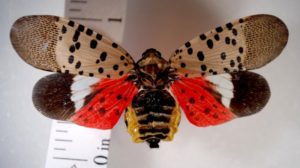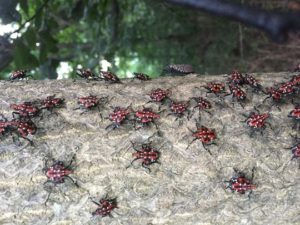Lanternflies and Learning from Your Sofa
May 12th, 2020
Be on the lookout for some new little bugs crawling around that you might never have seen before.
The spotted lanternfly – that voracious new bug from Asia that was discovered in Berks County in 2014 – has officially spread into Cumberland, York, and Perry counties in addition to Dauphin, Lancaster, Lebanon. It’s now pretty much in all of southcentral and southeastern Pennsylvania.
The state Department of Agriculture has extended the lanternfly quarantine to 26 Pennsylvania counties, including as far west as Beaver and Allegheny counties.
Most of this year’s spotted lanternflies will be hatched and out crawling this month, looking for tender young plant growth on which to feed.
The bug’s early stages don’t look anything like the inch-long adults with the distinctive set of orange-red spotted wings that can be seen when the wings are fully open. (The wings are gray with black spots when closed.)
In the first three stages of a lanternfly’s life, the bug is about the size of a crawling tick and is black with white and sometimes hard-to-see spots. That’s what to look for now.
By June, the lanternfly “toddlers” are slightly larger and turn a more noticeable red with white spots. They then morph into flying adults in July before dying in fall after the females lay eggs for the next year.
See Penn State Extension’s web page on identifying spotted lanternflies
One thing you can do to help Penn State University and the state Ag Department track (and hopefully contain) the spread of lanternflies is to “band” a tree or two. This involves wrapping three-inch-wide bands of sticky flypaper (available at hardware and farm-supply stores or online) around trees about four feet from the ground.
The flypaper captures the young lanternflies as they attempt to climb upwards in search of a leafy snack. (Penn State has a video on tree banding on its lanternfly web pages.)
To keep birds, butterflies, and beneficial flying insects from getting caught, add a wrap of chicken wire or screening a few inches out from the bands – ideally covered with cheesecloth or garden fabric.
Trapping doesn’t make a big dent in a lanternfly infestation, but it does help track the spread. If you’re in a county not already under quarantine and are getting lanternfly nymphs on your tree bands, take pictures and report the sighting to the state Department of Agriculture’s online reporting system. Or call the department’s Bad Fly Hotline at 888-422-3359.

Adult spotted lanternflies look like this.
(Credit: Holly Raguza, Pennsylvania Department of Agriculture)
Penn State Extension’s website is loaded with information on identifying, understanding, and controlling spotted lanternflies. These bugs eat a wide variety of plants and are especially worrisome to vintners since grapes are a favorite.
Penn State Extension also has been busy beefing up its web pages with all sorts of other gardening information since Covid-19 closed offices and wiped out the entire usual spring lineup of gardening talks, seminars, and programs.
The lockdown spawned a new wave of learning opportunities without ever leaving home.
Extension has ramped up its online stable of gardening information with new videos, free online courses, new and updated fact sheets, and in lieu of live talks, free online “webinars.”
If you’ve never done a webinar, it’s very much like a seminar with a presenter or two or three talking while showing photos and/or video clips on your computer screen. You can sign up to view them live, or in most cases, watch recorded versions of them later.
One of Penn State’s new offerings is a five-part Garden Hotline LIVE! webinar series in which Master Gardeners and Penn State Extension educators field and answer submitted questions from gardeners throughout Pennsylvania.
It runs live the first and third Fridays of each month from noon to 1 p.m. through June 19 on Extension’s Master Gardener Program web pages. (All of Penn State’s in-person seminars and events have been canceled through that date.)
This Friday’s session will focus on diagnosing plant problems. You can get a link to watch it on Extension’s website.
The June 5 session will focus on bugs in the garden, and the June 19 session will talk about summer gardening.
I also did a Facebook Q&A through PennLive last month if you didn’t already see that.
Since all of my spring talks got canceled, and all of you haven’t been able to get out either, I’m offering a “Garden Chat” service in addition to “unretiring” from garden designs.
I’ve found that lots of you have all kinds of gardening questions – from newbies trying to grow their first vegetable garden to gardeners trying to figure out why some of their plants are browning to plant-lovers interested in zeroing in the latest, greatest plant introductions.
Since not everyone wants designs or drawings, I’m offering half-hour to full-hour one-on-one phone or Facetime sessions in which you can pepper me with whatever questions are on your mind (gardening ones, that is).
Email me at george@georgeweigel.net to block out a time. A half-hour is $25, and a full hour is $50.
Some other free Penn State webinars coming up that might pique your interest:
Victory Gardening Reinvented, the fifth part of this 10-part weekly veggie-growing series is today (May 12) at noon.
Herbs for the Home Gardener, tonight (May 12) at 6 p.m.
Gardening for Pollinators, tomorrow (May 13) at noon.
Spotted Lanternfly in the Spotlight, part two of this four-part series is Mon., May 18, at noon.
And some recorded ones to check out:
The Garden Hotline Live debut show from April 17
Vegetable Garden Basics, Part 1
Vegetable Garden Basics, Part 2
Vegetable Garden Basics, Part 3
Video on how to build a raised bed
To tap into the hundreds of online fact sheets available from Penn State Extension, plus to sign up for Extension’s free Home Gardening News newsletter, visit Extension’s Home Gardening website.









